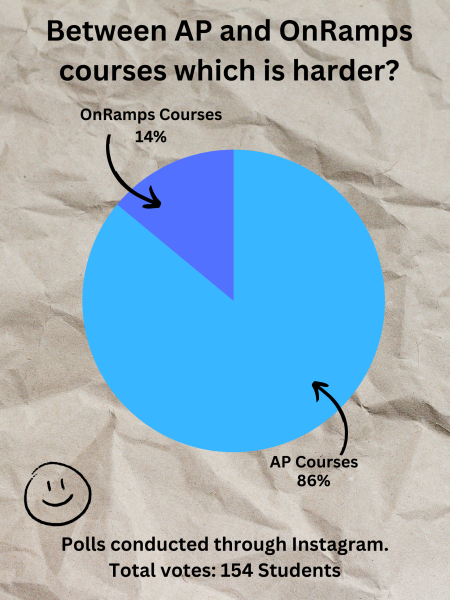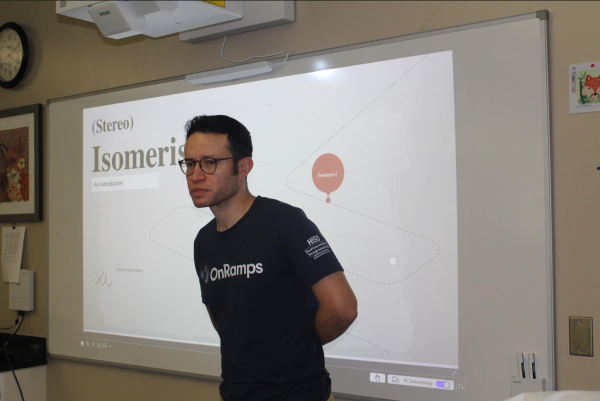- October 3 An un-pho-gettable celebration
- October 2 A look into the 2025 CITGO scholarship winners
- October 2 Bonded together: New afterschool O-chem class starts
- September 30 The itch to stitch
- September 25 Choir starts year on high note with car wash


Three Penny Press

Students spend three times longer on homework than average, survey reveals
Sonya Kulkarni and Pallavi Gorantla | Jan 9, 2022

Graphic by Sonya Kulkarni
The National Education Association and the National Parent Teacher Association have suggested that a healthy number of hours that students should be spending can be determined by the “10-minute rule.” This means that each grade level should have a maximum homework time incrementing by 10 minutes depending on their grade level (for instance, ninth-graders would have 90 minutes of homework, 10th-graders should have 100 minutes, and so on).
As ‘finals week’ rapidly approaches, students not only devote effort to attaining their desired exam scores but make a last attempt to keep or change the grade they have for semester one by making up homework assignments.
High schoolers reported doing an average of 2.7 hours of homework per weeknight, according to a study by the Washington Post from 2018 to 2020 of over 50,000 individuals. A survey of approximately 200 Bellaire High School students revealed that some students spend over three times this number.
The demographics of this survey included 34 freshmen, 43 sophomores, 54 juniors and 54 seniors on average.
When asked how many hours students spent on homework in a day on average, answers ranged from zero to more than nine with an average of about four hours. In contrast, polled students said that about one hour of homework would constitute a healthy number of hours.
Junior Claire Zhang said she feels academically pressured in her AP schedule, but not necessarily by the classes.
“The class environment in AP classes can feel pressuring because everyone is always working hard and it makes it difficult to keep up sometimes.” Zhang said.
A total of 93 students reported that the minimum grade they would be satisfied with receiving in a class would be an A. This was followed by 81 students, who responded that a B would be the minimum acceptable grade. 19 students responded with a C and four responded with a D.
“I am happy with the classes I take, but sometimes it can be very stressful to try to keep up,” freshman Allyson Nguyen said. “I feel academically pressured to keep an A in my classes.”
Up to 152 students said that grades are extremely important to them, while 32 said they generally are more apathetic about their academic performance.
Last year, nine valedictorians graduated from Bellaire. They each achieved a grade point average of 5.0. HISD has never seen this amount of valedictorians in one school, and as of now there are 14 valedictorians.
“I feel that it does degrade the title of valedictorian because as long as a student knows how to plan their schedule accordingly and make good grades in the classes, then anyone can be valedictorian,” Zhang said.
Bellaire offers classes like physical education and health in the summer. These summer classes allow students to skip the 4.0 class and not put it on their transcript. Some electives also have a 5.0 grade point average like debate.
Close to 200 students were polled about Bellaire having multiple valedictorians. They primarily answered that they were in favor of Bellaire having multiple valedictorians, which has recently attracted significant acclaim .
Senior Katherine Chen is one of the 14 valedictorians graduating this year and said that she views the class of 2022 as having an extraordinary amount of extremely hardworking individuals.
“I think it was expected since freshman year since most of us knew about the others and were just focused on doing our personal best,” Chen said.
Chen said that each valedictorian achieved the honor on their own and deserves it.
“I’m honestly very happy for the other valedictorians and happy that Bellaire is such a good school,” Chen said. “I don’t feel any less special with 13 other valedictorians.”
Nguyen said that having multiple valedictorians shows just how competitive the school is.
“It’s impressive, yet scary to think about competing against my classmates,” Nguyen said.
Offering 30 AP classes and boasting a significant number of merit-based scholars Bellaire can be considered a competitive school.
“I feel academically challenged but not pressured,” Chen said. “Every class I take helps push me beyond my comfort zone but is not too much to handle.”
Students have the opportunity to have off-periods if they’ve met all their credits and are able to maintain a high level of academic performance. But for freshmen like Nguyen, off periods are considered a privilege. Nguyen said she usually has an hour to five hours worth of work everyday.
“Depending on the day, there can be a lot of work, especially with extra curriculars,” Nguyen said. “Although, I am a freshman, so I feel like it’s not as bad in comparison to higher grades.”
According to the survey of Bellaire students, when asked to evaluate their agreement with the statement “students who get better grades tend to be smarter overall than students who get worse grades,” responders largely disagreed.
Zhang said that for students on the cusp of applying to college, it can sometimes be hard to ignore the mental pressure to attain good grades.
“As a junior, it’s really easy to get extremely anxious about your GPA,” Zhang said. “It’s also a very common but toxic practice to determine your self-worth through your grades but I think that we just need to remember that our mental health should also come first. Sometimes, it’s just not the right day for everyone and one test doesn’t determine our smartness.”
Your donation will support the student journalists of Bellaire High School. Your contribution will allow us to purchase equipment and cover our annual website hosting costs.

A look into the 2025 CITGO scholarship winners

Athlete spotlight: Recap of summer sports camps

HUMANS OF BELLAIRE – Courtney Meekins

Getting on the green

Making the switch

An un-pho-gettable celebration

Bonded together: New afterschool O-chem class starts
![suggested homework time Students were able to learn suturing and ask questions related to going pre-med. "Most of [the medical students were] second years, [so] they were able to talk about their experiences at medical school," Junior Miranda Wang said.](https://threepennypress.org/wp-content/uploads/2024/09/MEDCLUBIMG4-600x400.jpg)
The itch to stitch

Choir starts year on high note with car wash
Comments (8).
Cancel reply
Your email address will not be published. Required fields are marked *
Anonymous • Jul 16, 2024 at 3:27 pm
didnt realy help
Anonymous • Nov 21, 2023 at 10:32 am
It’s not really helping me understand how much.
josh • May 9, 2023 at 9:58 am
Kassie • May 6, 2022 at 12:29 pm
Im using this for an English report. This is great because on of my sources needed to be from another student. Homework drives me insane. Im glad this is very updated too!!
Kaylee Swaim • Jan 25, 2023 at 9:21 pm
I am also using this for an English report. I have to do an argumentative essay about banning homework in schools and this helps sooo much!
Izzy McAvaney • Mar 15, 2023 at 6:43 pm
I am ALSO using this for an English report on cutting down school days, homework drives me insane!!
E. Elliott • Apr 25, 2022 at 6:42 pm
I’m from Louisiana and am actually using this for an English Essay thanks for the information it was very informative.
Nabila Wilson • Jan 10, 2022 at 6:56 pm
Interesting with the polls! I didn’t realize about 14 valedictorians, that’s crazy.

What’s the Right Amount of Homework?
Decades of research show that homework has some benefits, especially for students in middle and high school—but there are risks to assigning too much.
Your content has been saved!
Many teachers and parents believe that homework helps students build study skills and review concepts learned in class. Others see homework as disruptive and unnecessary, leading to burnout and turning kids off to school. Decades of research show that the issue is more nuanced and complex than most people think: Homework is beneficial, but only to a degree. Students in high school gain the most, while younger kids benefit much less.
The National PTA and the National Education Association support the “ 10-minute homework guideline ”—a nightly 10 minutes of homework per grade level. But many teachers and parents are quick to point out that what matters is the quality of the homework assigned and how well it meets students’ needs, not the amount of time spent on it.
The guideline doesn’t account for students who may need to spend more—or less—time on assignments. In class, teachers can make adjustments to support struggling students, but at home, an assignment that takes one student 30 minutes to complete may take another twice as much time—often for reasons beyond their control. And homework can widen the achievement gap, putting students from low-income households and students with learning disabilities at a disadvantage.
However, the 10-minute guideline is useful in setting a limit: When kids spend too much time on homework, there are real consequences to consider.
Small Benefits for Elementary Students
As young children begin school, the focus should be on cultivating a love of learning, and assigning too much homework can undermine that goal. And young students often don’t have the study skills to benefit fully from homework, so it may be a poor use of time (Cooper, 1989 ; Cooper et al., 2006 ; Marzano & Pickering, 2007 ). A more effective activity may be nightly reading, especially if parents are involved. The benefits of reading are clear: If students aren’t proficient readers by the end of third grade, they’re less likely to succeed academically and graduate from high school (Fiester, 2013 ).
For second-grade teacher Jacqueline Fiorentino, the minor benefits of homework did not outweigh the potential drawback of turning young children against school at an early age, so she experimented with dropping mandatory homework. “Something surprising happened: They started doing more work at home,” Fiorentino writes . “This inspiring group of 8-year-olds used their newfound free time to explore subjects and topics of interest to them.” She encouraged her students to read at home and offered optional homework to extend classroom lessons and help them review material.
Moderate Benefits for Middle School Students
As students mature and develop the study skills necessary to delve deeply into a topic—and to retain what they learn—they also benefit more from homework. Nightly assignments can help prepare them for scholarly work, and research shows that homework can have moderate benefits for middle school students (Cooper et al., 2006 ). Recent research also shows that online math homework, which can be designed to adapt to students’ levels of understanding, can significantly boost test scores (Roschelle et al., 2016 ).
There are risks to assigning too much, however: A 2015 study found that when middle school students were assigned more than 90 to 100 minutes of daily homework, their math and science test scores began to decline (Fernández-Alonso, Suárez-Álvarez, & Muñiz, 2015 ). Crossing that upper limit can drain student motivation and focus. The researchers recommend that “homework should present a certain level of challenge or difficulty, without being so challenging that it discourages effort.” Teachers should avoid low-effort, repetitive assignments, and assign homework “with the aim of instilling work habits and promoting autonomous, self-directed learning.”
In other words, it’s the quality of homework that matters, not the quantity. Brian Sztabnik, a veteran middle and high school English teacher, suggests that teachers take a step back and ask themselves these five questions :
- How long will it take to complete?
- Have all learners been considered?
- Will an assignment encourage future success?
- Will an assignment place material in a context the classroom cannot?
- Does an assignment offer support when a teacher is not there?
More Benefits for High School Students, but Risks as Well
By the time they reach high school, students should be well on their way to becoming independent learners, so homework does provide a boost to learning at this age, as long as it isn’t overwhelming (Cooper et al., 2006 ; Marzano & Pickering, 2007 ). When students spend too much time on homework—more than two hours each night—it takes up valuable time to rest and spend time with family and friends. A 2013 study found that high school students can experience serious mental and physical health problems, from higher stress levels to sleep deprivation, when assigned too much homework (Galloway, Conner, & Pope, 2013 ).
Homework in high school should always relate to the lesson and be doable without any assistance, and feedback should be clear and explicit.
Teachers should also keep in mind that not all students have equal opportunities to finish their homework at home, so incomplete homework may not be a true reflection of their learning—it may be more a result of issues they face outside of school. They may be hindered by issues such as lack of a quiet space at home, resources such as a computer or broadband connectivity, or parental support (OECD, 2014 ). In such cases, giving low homework scores may be unfair.
Since the quantities of time discussed here are totals, teachers in middle and high school should be aware of how much homework other teachers are assigning. It may seem reasonable to assign 30 minutes of daily homework, but across six subjects, that’s three hours—far above a reasonable amount even for a high school senior. Psychologist Maurice Elias sees this as a common mistake: Individual teachers create homework policies that in aggregate can overwhelm students. He suggests that teachers work together to develop a school-wide homework policy and make it a key topic of back-to-school night and the first parent-teacher conferences of the school year.
Parents Play a Key Role
Homework can be a powerful tool to help parents become more involved in their child’s learning (Walker et al., 2004 ). It can provide insights into a child’s strengths and interests, and can also encourage conversations about a child’s life at school. If a parent has positive attitudes toward homework, their children are more likely to share those same values, promoting academic success.
But it’s also possible for parents to be overbearing, putting too much emphasis on test scores or grades, which can be disruptive for children (Madjar, Shklar, & Moshe, 2015 ). Parents should avoid being overly intrusive or controlling—students report feeling less motivated to learn when they don’t have enough space and autonomy to do their homework (Orkin, May, & Wolf, 2017 ; Patall, Cooper, & Robinson, 2008 ; Silinskas & Kikas, 2017 ). So while homework can encourage parents to be more involved with their kids, it’s important to not make it a source of conflict.
How Much Homework Is Enough? Depends Who You Ask

- Share article
Editor’s note: This is an adapted excerpt from You, Your Child, and School: Navigate Your Way to the Best Education ( Viking)—the latest book by author and speaker Sir Ken Robinson (co-authored with Lou Aronica), published in March. For years, Robinson has been known for his radical work on rekindling creativity and passion in schools, including three bestselling books (also with Aronica) on the topic. His TED Talk “Do Schools Kill Creativity?” holds the record for the most-viewed TED talk of all time, with more than 50 million views. While Robinson’s latest book is geared toward parents, it also offers educators a window into the kinds of education concerns parents have for their children, including on the quality and quantity of homework.
The amount of homework young people are given varies a lot from school to school and from grade to grade. In some schools and grades, children have no homework at all. In others, they may have 18 hours or more of homework every week. In the United States, the accepted guideline, which is supported by both the National Education Association and the National Parent Teacher Association, is the 10-minute rule: Children should have no more than 10 minutes of homework each day for each grade reached. In 1st grade, children should have 10 minutes of daily homework; in 2nd grade, 20 minutes; and so on to the 12th grade, when on average they should have 120 minutes of homework each day, which is about 10 hours a week. It doesn’t always work out that way.
In 2013, the University of Phoenix College of Education commissioned a survey of how much homework teachers typically give their students. From kindergarten to 5th grade, it was just under three hours per week; from 6th to 8th grade, it was 3.2 hours; and from 9th to 12th grade, it was 3.5 hours.
There are two points to note. First, these are the amounts given by individual teachers. To estimate the total time children are expected to spend on homework, you need to multiply these hours by the number of teachers they work with. High school students who work with five teachers in different curriculum areas may find themselves with 17.5 hours or more of homework a week, which is the equivalent of a part-time job. The other factor is that these are teachers’ estimates of the time that homework should take. The time that individual children spend on it will be more or less than that, according to their abilities and interests. One child may casually dash off a piece of homework in half the time that another will spend laboring through in a cold sweat.
Do students have more homework these days than previous generations? Given all the variables, it’s difficult to say. Some studies suggest they do. In 2007, a study from the National Center for Education Statistics found that, on average, high school students spent around seven hours a week on homework. A similar study in 1994 put the average at less than five hours a week. Mind you, I [Robinson] was in high school in England in the 1960s and spent a lot more time than that—though maybe that was to do with my own ability. One way of judging this is to look at how much homework your own children are given and compare it to what you had at the same age.
Many parents find it difficult to help their children with subjects they’ve not studied themselves for a long time, if at all.
There’s also much debate about the value of homework. Supporters argue that it benefits children, teachers, and parents in several ways:
- Children learn to deepen their understanding of specific content, to cover content at their own pace, to become more independent learners, to develop problem-solving and time-management skills, and to relate what they learn in school to outside activities.
- Teachers can see how well their students understand the lessons; evaluate students’ individual progress, strengths, and weaknesses; and cover more content in class.
- Parents can engage practically in their children’s education, see firsthand what their children are being taught in school, and understand more clearly how they’re getting on—what they find easy and what they struggle with in school.
Want to know more about Sir Ken Robinson? Check out our Q&A with him.
Q&A With Sir Ken Robinson
Ashley Norris is assistant dean at the University of Phoenix College of Education. Commenting on her university’s survey, she says, “Homework helps build confidence, responsibility, and problem-solving skills that can set students up for success in high school, college, and in the workplace.”
That may be so, but many parents find it difficult to help their children with subjects they’ve not studied themselves for a long time, if at all. Families have busy lives, and it can be hard for parents to find time to help with homework alongside everything else they have to cope with. Norris is convinced it’s worth the effort, especially, she says, because in many schools, the nature of homework is changing. One influence is the growing popularity of the so-called flipped classroom.
In the stereotypical classroom, the teacher spends time in class presenting material to the students. Their homework consists of assignments based on that material. In the flipped classroom, the teacher provides the students with presentational materials—videos, slides, lecture notes—which the students review at home and then bring questions and ideas to school where they work on them collaboratively with the teacher and other students. As Norris notes, in this approach, homework extends the boundaries of the classroom and reframes how time in school can be used more productively, allowing students to “collaborate on learning, learn from each other, maybe critique [each other’s work], and share those experiences.”
Even so, many parents and educators are increasingly concerned that homework, in whatever form it takes, is a bridge too far in the pressured lives of children and their families. It takes away from essential time for their children to relax and unwind after school, to play, to be young, and to be together as a family. On top of that, the benefits of homework are often asserted, but they’re not consistent, and they’re certainly not guaranteed.
Sign Up for EdWeek Update
Edweek top school jobs.

Sign Up & Sign In


A new, streamlined version of Intervention Central is coming in December 2023. The new site will eliminate user login accounts. If you have a login account, be sure to download and save any documents of importance from that account, as they will be erased when the website is revised.
- Academic Interventions
- Behavior Interventions
- CBM/Downloads
How To: Choose the Right Amount of Daily Homework
|
| |||
|
| | | |
| 1 | 10 Minutes | -- | 10-45 Minutes |
| 2 | 20 Minutes | -- | 10-45 Minutes |
| 3 | 30 Minutes | -- | 10-45 Minutes |
| 4 | 40 Minutes | -- | 45-90 Minutes |
| 5 | 50 Minutes | -- | 45-90 Minutes |
| 6 | 1 Hour | -- | 45-90 Minutes |
| 7 | 1 Hour 10 Minutes | 1-2 Hours | 1-2 Hours |
| 8 | 1 Hour 20 Minutes | 1-2 Hours | 1-2 Hours |
| 9 | 1 Hour 30 Minutes | 1.5-2.5 Hours | 1-2 Hours |
| 10 | 1 Hour 40 Minutes | 1.5-2.5 Hours | 1.5-2.5 Hours |
| 11 | 1 Hour 50 Minutes | 1.5-2.5 Hours | 1.5-2.5 Hours |
| 12 | 2 Hours | 1.5-2.5 Hours | 1.5-2.5 Hours |
Despite the differences in the recommendations from these sources, the table shows broad agreement about how much homework to assign at each grade. At grades 1-3, homework should be limited to an hour or less per day, while in grades 4-6, homework should not exceed 90 minutes. The upper limit in grades 7-8 is 2 hours and the limit in high school should be 2.5 hours.
Teachers can use the homework time recommendations included here as a point of comparison: in particular, schools should note that assigning homework that exceeds the upper limit of these time estimates is not likely to result in additional learning gains--and may even be counter-productive (Cooper, Robinson, & Patall, 2006).
It should also be remembered that the amount of homework assigned each day is not in itself a sign of high academic standards. Homework becomes a powerful tool to promote learning only when students grasp the purpose of each homework assignment, clearly understand homework directions, perceive that homework tasks are instructionally relevant, and receive timely performance feedback (e.g., teacher comments; grades) on submitted homework (Jenson, Sheridan, Olympia, & Andrews, 1994).

Attachments
- Download This Blog Entry in PDF Format: How To: Choose the Right Amount of Daily Homework
- Barkley, R. A. (2008). 80+ classroom accommodations for children or teens with ADHD. The ADHD Report, 16 (4), 7-10.
- Cooper, H., Robinson, J. C., & Patall, E A. (2006). Does homework improve academic achievement? A synthesis of research, 1987-2003. Review of Educational Research, 76 (1), 1-62.
- Jenson, W. R., Sheridan, S. M., Olympia, D., & Andrews, D. (1994). Homework and students with learning disabilities and behavior disorders: A practical, parent-based approach. Journal of Learning Disabilities, 27 , 538-548.
- Newsletters

How Much Time Should Be Spent On Homework?
- Dr. Sam Goldstein , Sydney S. Zentall

At the elementary level we suggest that homework is brief, at your child’s ability level and involve frequent, voluntary and high interest activities. Young students require high levels of feedback and/or supervision to help them complete assignments correctly. Accurate homework completion is influenced by your child’s ability, the difficulty of the task and the amount of feedback your child receives. When assigning homework, your child’s teachers may struggle to create a balance at this age between ability, task difficulty and feedback. Unfortunately, there are no simple guiding principles. We can assure you, however, that your input and feedback on a nightly basis is an essential component in helping your child benefit from the homework experience. In first through third grade, students should receive one to three assignments per week, taking them no more than fifteen to twenty minutes. In fourth through sixth grade, students should receive two to four assignments per week, lasting between fifteen and forty-five minutes. At this age, the primarily goal of homework is to help your child develop the independent work and learning skills that will become critical in the higher grades. In the upper grades, the more time spent on homework the greater the achievement gains.
For students in middle and high school grades there are greater overall benefits from time engaged in practicing and thinking about school work. These benefits do not appear to depend as much upon immediate supervision or feedback as they do for elementary students. In seventh through ninth grade we recommend students receive three to five sets of assignments per week, lasting between forty-five and seventy-five minutes per set. In high school students will receive four to five sets of homework per week, taking them between seventy-five and 150 minutes per set to complete.
As children progress through school, homework and the amount of time engaged in homework increases in importance. Due to the significance of homework at the older age levels, it is not surprising that there is more homework assigned. Furthermore, homework is always assigned in college preparatory classes and assigned at least three quarters of the time in special education and vocational training classes. Thus at any age, homework may indicate our academic expectations of children.
Regardless of the amount of homework assigned, many students unsuccessful or struggling in school, spend less rather than more time engaged in homework. It is not surprising that students spending less time completing homework may eventually not achieve as consistently as those who complete their homework. Does this mean that time devoted to homework is the key component necessary for achievement? We are not completely certain. Some American educators have concluded that if students in America spent as much time doing homework as students in Asian countries they might perform academically as well. It is tempting to assume such a cause and effect relationship. However, this relationship appears to be an overly simple conclusion. We know that homework is important as one of several influential factors in school success. However, other variables, including student ability, achievement, motivation and teaching quality influence the time students spend with homework tasks. Many students and their parents have told us they experience less difficulty being motivated and completing homework in classes in which they enjoyed the subject, the instruction, the assignments and the teachers.
The benefits from homework are the greatest for students completing the most homework and doing so correctly. Thus, students who devote time to homework are probably on a path to improved achievement. This path also includes higher quality instruction, greater achievement motivation and better skill levels.
This column is excerpted and condensed from, Seven Steps to Homework Success: A Family Guide for Solving Common Homework Problems by Sydney S. Zentall, Ph.D. and Sam Goldstein, Ph.D. (1999, Specialty Press, Inc.).
- More Resources

General Articles

Homework Articles

Forensic Updates

Golf Articles
- Future Students
- Current Students
- Faculty/Staff

News and Media
- News & Media Home
- Research Stories
- School’s In
- In the Media
You are here
More than two hours of homework may be counterproductive, research suggests.

A Stanford education researcher found that too much homework can negatively affect kids, especially their lives away from school, where family, friends and activities matter. "Our findings on the effects of homework challenge the traditional assumption that homework is inherently good," wrote Denise Pope , a senior lecturer at the Stanford Graduate School of Education and a co-author of a study published in the Journal of Experimental Education . The researchers used survey data to examine perceptions about homework, student well-being and behavioral engagement in a sample of 4,317 students from 10 high-performing high schools in upper-middle-class California communities. Along with the survey data, Pope and her colleagues used open-ended answers to explore the students' views on homework. Median household income exceeded $90,000 in these communities, and 93 percent of the students went on to college, either two-year or four-year. Students in these schools average about 3.1 hours of homework each night. "The findings address how current homework practices in privileged, high-performing schools sustain students' advantage in competitive climates yet hinder learning, full engagement and well-being," Pope wrote. Pope and her colleagues found that too much homework can diminish its effectiveness and even be counterproductive. They cite prior research indicating that homework benefits plateau at about two hours per night, and that 90 minutes to two and a half hours is optimal for high school. Their study found that too much homework is associated with: • Greater stress : 56 percent of the students considered homework a primary source of stress, according to the survey data. Forty-three percent viewed tests as a primary stressor, while 33 percent put the pressure to get good grades in that category. Less than 1 percent of the students said homework was not a stressor. • Reductions in health : In their open-ended answers, many students said their homework load led to sleep deprivation and other health problems. The researchers asked students whether they experienced health issues such as headaches, exhaustion, sleep deprivation, weight loss and stomach problems. • Less time for friends, family and extracurricular pursuits : Both the survey data and student responses indicate that spending too much time on homework meant that students were "not meeting their developmental needs or cultivating other critical life skills," according to the researchers. Students were more likely to drop activities, not see friends or family, and not pursue hobbies they enjoy. A balancing act The results offer empirical evidence that many students struggle to find balance between homework, extracurricular activities and social time, the researchers said. Many students felt forced or obligated to choose homework over developing other talents or skills. Also, there was no relationship between the time spent on homework and how much the student enjoyed it. The research quoted students as saying they often do homework they see as "pointless" or "mindless" in order to keep their grades up. "This kind of busy work, by its very nature, discourages learning and instead promotes doing homework simply to get points," said Pope, who is also a co-founder of Challenge Success , a nonprofit organization affiliated with the GSE that conducts research and works with schools and parents to improve students' educational experiences.. Pope said the research calls into question the value of assigning large amounts of homework in high-performing schools. Homework should not be simply assigned as a routine practice, she said. "Rather, any homework assigned should have a purpose and benefit, and it should be designed to cultivate learning and development," wrote Pope. High-performing paradox In places where students attend high-performing schools, too much homework can reduce their time to foster skills in the area of personal responsibility, the researchers concluded. "Young people are spending more time alone," they wrote, "which means less time for family and fewer opportunities to engage in their communities." Student perspectives The researchers say that while their open-ended or "self-reporting" methodology to gauge student concerns about homework may have limitations – some might regard it as an opportunity for "typical adolescent complaining" – it was important to learn firsthand what the students believe. The paper was co-authored by Mollie Galloway from Lewis and Clark College and Jerusha Conner from Villanova University.
Clifton B. Parker is a writer at the Stanford News Service .
More Stories

⟵ Go to all Research Stories
Get the Educator
Subscribe to our monthly newsletter.
Stanford Graduate School of Education
482 Galvez Mall Stanford, CA 94305-3096 Tel: (650) 723-2109
- Contact Admissions
- GSE Leadership
- Site Feedback
- Web Accessibility
- Career Resources
- Faculty Open Positions
- Explore Courses
- Academic Calendar
- Office of the Registrar
- Cubberley Library
- StanfordWho
- StanfordYou
Improving lives through learning

- Stanford Home
- Maps & Directions
- Search Stanford
- Emergency Info
- Terms of Use
- Non-Discrimination
- Accessibility
© Stanford University , Stanford , California 94305 .
Is Homework Good for Kids? Here’s What the Research Says
A s kids return to school, debate is heating up once again over how they should spend their time after they leave the classroom for the day.
The no-homework policy of a second-grade teacher in Texas went viral last week , earning praise from parents across the country who lament the heavy workload often assigned to young students. Brandy Young told parents she would not formally assign any homework this year, asking students instead to eat dinner with their families, play outside and go to bed early.
But the question of how much work children should be doing outside of school remains controversial, and plenty of parents take issue with no-homework policies, worried their kids are losing a potential academic advantage. Here’s what you need to know:
For decades, the homework standard has been a “10-minute rule,” which recommends a daily maximum of 10 minutes of homework per grade level. Second graders, for example, should do about 20 minutes of homework each night. High school seniors should complete about two hours of homework each night. The National PTA and the National Education Association both support that guideline.
But some schools have begun to give their youngest students a break. A Massachusetts elementary school has announced a no-homework pilot program for the coming school year, lengthening the school day by two hours to provide more in-class instruction. “We really want kids to go home at 4 o’clock, tired. We want their brain to be tired,” Kelly Elementary School Principal Jackie Glasheen said in an interview with a local TV station . “We want them to enjoy their families. We want them to go to soccer practice or football practice, and we want them to go to bed. And that’s it.”
A New York City public elementary school implemented a similar policy last year, eliminating traditional homework assignments in favor of family time. The change was quickly met with outrage from some parents, though it earned support from other education leaders.
New solutions and approaches to homework differ by community, and these local debates are complicated by the fact that even education experts disagree about what’s best for kids.
The research
The most comprehensive research on homework to date comes from a 2006 meta-analysis by Duke University psychology professor Harris Cooper, who found evidence of a positive correlation between homework and student achievement, meaning students who did homework performed better in school. The correlation was stronger for older students—in seventh through 12th grade—than for those in younger grades, for whom there was a weak relationship between homework and performance.
Cooper’s analysis focused on how homework impacts academic achievement—test scores, for example. His report noted that homework is also thought to improve study habits, attitudes toward school, self-discipline, inquisitiveness and independent problem solving skills. On the other hand, some studies he examined showed that homework can cause physical and emotional fatigue, fuel negative attitudes about learning and limit leisure time for children. At the end of his analysis, Cooper recommended further study of such potential effects of homework.
Despite the weak correlation between homework and performance for young children, Cooper argues that a small amount of homework is useful for all students. Second-graders should not be doing two hours of homework each night, he said, but they also shouldn’t be doing no homework.
Not all education experts agree entirely with Cooper’s assessment.
Cathy Vatterott, an education professor at the University of Missouri-St. Louis, supports the “10-minute rule” as a maximum, but she thinks there is not sufficient proof that homework is helpful for students in elementary school.
“Correlation is not causation,” she said. “Does homework cause achievement, or do high achievers do more homework?”
Vatterott, the author of Rethinking Homework: Best Practices That Support Diverse Needs , thinks there should be more emphasis on improving the quality of homework tasks, and she supports efforts to eliminate homework for younger kids.
“I have no concerns about students not starting homework until fourth grade or fifth grade,” she said, noting that while the debate over homework will undoubtedly continue, she has noticed a trend toward limiting, if not eliminating, homework in elementary school.
The issue has been debated for decades. A TIME cover in 1999 read: “Too much homework! How it’s hurting our kids, and what parents should do about it.” The accompanying story noted that the launch of Sputnik in 1957 led to a push for better math and science education in the U.S. The ensuing pressure to be competitive on a global scale, plus the increasingly demanding college admissions process, fueled the practice of assigning homework.
“The complaints are cyclical, and we’re in the part of the cycle now where the concern is for too much,” Cooper said. “You can go back to the 1970s, when you’ll find there were concerns that there was too little, when we were concerned about our global competitiveness.”
Cooper acknowledged that some students really are bringing home too much homework, and their parents are right to be concerned.
“A good way to think about homework is the way you think about medications or dietary supplements,” he said. “If you take too little, they’ll have no effect. If you take too much, they can kill you. If you take the right amount, you’ll get better.”
More Must-Reads from TIME
- Introducing the 2024 TIME100 Next
- The Reinvention of J.D. Vance
- How to Survive Election Season Without Losing Your Mind
- Welcome to the Golden Age of Scams
- Did the Pandemic Break Our Brains?
- The Many Lives of Jack Antonoff
- 33 True Crime Documentaries That Shaped the Genre
- Why Gut Health Issues Are More Common in Women
Write to Katie Reilly at [email protected]
Internet Explorer is no longer supported
Please upgrade to Microsoft Edge , Google Chrome , or Firefox .
Lo sentimos, la página que usted busca no se ha podido encontrar. Puede intentar su búsqueda de nuevo o visitar la lista de temas populares.
Get this as a PDF
Enter email to download and get news and resources in your inbox.
Share this on social
Strategies to make homework go more smoothly.
Routines and incentive systems to help kids succeed
Writer: Peg Dawson, EdD, NCSP
Clinical Experts: Peg Dawson, EdD, NCSP , Karol Espejo, LCSW
Here is the best guide to helping kids do homework successfully that we’ve seen, published by the National Association of School Psychologists on their website, NASPonline.org . Our thanks to NASP for sharing it with us.
There are two key strategies parents can draw on to reduce homework hassles. The first is to establish clear routines around homework, including when and where homework gets done and setting up daily schedules for homework. The second is to build in rewards or incentives to use with children for whom “good grades” is not a sufficient reward for doing homework.
Homework Routines
Tasks are easiest to accomplish when tied to specific routines. By establishing daily routines for homework completion, you will not only make homework go more smoothly, but you will also be fostering a sense of order your child can apply to later life, including college and work.
Step 1. Find a location in the house where homework will be done. The right location will depend on your child and the culture of your family. Some children do best at a desk in their bedroom. It is a quiet location, away from the hubbub of family noise. Other children become too distracted by the things they keep in their bedroom and do better at a place removed from those distractions, like the dining room table. Some children need to work by themselves. Others need to have parents nearby to help keep them on task and to answer questions when problems arise. Ask your child where the best place is to work. Both you and your child need to discuss pros and cons of different settings to arrive at a mutually agreed upon location.
Step 2. Set up a homework center. Once you and your child have identified a location, fix it up as a home office/homework center. Make sure there is a clear workspace large enough to set out all the materials necessary for completing assignments. Outfit the homework center with the kinds of supplies your child is most likely to need, such as pencils, pens, colored markers, rulers, scissors, a dictionary and thesaurus, graph paper, construction paper, glue and cellophane tape, lined paper, a calculator, spell checker, and, depending on the age and needs of your child, a computer or laptop. If the homework center is a place that will be used for other things (such as the dining room table), then your child can keep the supplies in a portable crate or bin. If possible, the homework center should include a bulletin board that can hold a monthly calendar on which your child can keep track of longterm assignments. Allowing children some leeway in decorating the homework center can help them feel at home there, but you should be careful that it does not become too cluttered with distracting materials.
Step 3. Establish a homework time. Your child should get in the habit of doing homework at the same time every day. The time may vary depending on the individual child. Some children need a break right after school to get some exercise and have a snack. Others need to start homework while they are still in a school mode (i.e., right after school when there is still some momentum left from getting through the day). In general, it may be best to get homework done either before dinner or as early in the evening as the child can tolerate. The later it gets, the more tired the child becomes and the more slowly the homework gets done.
Step 4. Establish a daily homework schedule. In general, at least into middle school, the homework session should begin with your sitting down with your child and drawing up a homework schedule. You should review all the assignments and make sure your child understands them and has all the necessary materials. Ask your child to estimate how long it will take to complete each assignment. Then ask when each assignment will get started. If your child needs help with any assignment , then this should be determined at the beginning so that the start times can take into account parent availability. A Daily Homework Planner is included at the end of this handout and contains a place for identifying when breaks may be taken and what rewards may be earned.
Incentive Systems
Many children who are not motivated by the enjoyment of doing homework are motivated by the high grade they hope to earn as a result of doing a quality job. Thus, the grade is an incentive, motivating the child to do homework with care and in a timely manner. For children who are not motivated by grades, parents will need to look for other rewards to help them get through their nightly chores. Incentive systems fall into two categories: simple and elaborate.
Simple incentive systems. The simplest incentive system is reminding the child of a fun activity to do when homework is done. It may be a favorite television show, a chance to spend some time with a video or computer game, talking on the telephone or instant messaging, or playing a game with a parent. This system of withholding fun things until the drudgery is over is sometimes called Grandma’s Law because grandmothers often use it quite effectively (“First take out the trash, then you can have chocolate chip cookies.”). Having something to look forward to can be a powerful incentive to get the hard work done. When parents remind children of this as they sit down at their desks they may be able to spark the engine that drives the child to stick with the work until it is done.
Elaborate incentive systems. These involve more planning and more work on the part of parents but in some cases are necessary to address more significant homework problems. More complex incentives systems might include a structure for earning points that could be used to “purchase” privileges or rewards or a system that provides greater reward for accomplishing more difficult homework tasks. These systems work best when parents and children together develop them. Giving children input gives them a sense of control and ownership, making the system more likely to succeed. We have found that children are generally realistic in setting goals and deciding on rewards and penalties when they are involved in the decision-making process.
Building in breaks. These are good for the child who cannot quite make it to the end without a small reward en route. When creating the daily homework schedule, it may be useful with these children to identify when they will take their breaks. Some children prefer to take breaks at specific time intervals (every 15 minutes), while others do better when the breaks occur after they finish an activity. If you use this approach, you should discuss with your child how long the breaks will last and what will be done during the breaks (get a snack, call a friend, play one level on a video game). The Daily Homework Planner includes sections where breaks and end-of-homework rewards can be identified.
Building in choice. This can be an effective strategy for parents to use with children who resist homework. Choice can be incorporated into both the order in which the child agrees to complete assignments and the schedule they will follow to get the work done. Building in choice not only helps motivate children but can also reduce power struggles between parents and children.
Developing Incentive Systems
Step 1. Describe the problem behaviors. Parents and children decide which behaviors are causing problems at homework time. For some children putting homework off to the last minute is the problem; for others, it is forgetting materials or neglecting to write down assignments. Still others rush through their work and make careless mistakes, while others dawdle over assignments, taking hours to complete what should take only a few minutes. It is important to be as specific as possible when describing the problem behaviors. The problem behavior should be described as behaviors that can be seen or heard; for instance, complains about h omework or rushes through homework, making many mistakes are better descriptors than has a bad attitude or is lazy.
Step 2. Set a goal. Usually the goal relates directly to the problem behavior. For instance, if not writing down assignments is the problem, the goal might be: “Joe will write down his assignments in his assignment book for every class.”
Step 3. Decide on possible rewards and penalties. Homework incentive systems work best when children have a menu of rewards to choose from, since no single reward will be attractive for long. We recommend a point system in which points can be earned for the goal behaviors and traded in for the reward the child wants to earn. The bigger the reward, the more points the child will need to earn it. The menu should include both larger, more expensive rewards that may take a week or a month to earn and smaller, inexpensive rewards that can be earned daily. It may also be necessary to build penalties into the system. This is usually the loss of a privilege (such as the chance to watch a favorite TV show or the chance to talk on the telephone to a friend).
Once the system is up and running, and if you find your child is earning more penalties than rewards, then the program needs to be revised so that your child can be more successful. Usually when this kind of system fails, we think of it as a design failure rather than the failure of the child to respond to rewards. It may be a good idea if you are having difficulty designing a system that works to consult a specialist, such as a school psychologist or counselor, for assistance.
Step 4. Write a homework contract. The contract should say exactly what the child agrees to do and exactly what the parents’ roles and responsibilities will be. When the contract is in place, it should reduce some of the tension parents and kids often experience around homework. For instance, if part of the contract is that the child will earn a point for not complaining about homework, then if the child does complain, this should not be cause for a battle between parent and child: the child simply does not earn that point. Parents should also be sure to praise their children for following the contract. It will be important for parents to agree to a contract they can live with; that is, avoiding penalties they are either unable or unwilling to impose (e.g., if both parents work and are not at home, they cannot monitor whether a child is beginning homework right after school, so an alternative contract may need to be written).
We have found that it is a rare incentive system that works the first time. Parents should expect to try it out and redesign it to work the kinks out. Eventually, once the child is used to doing the behaviors specified in the contract, the contract can be rewritten to work on another problem behavior. Your child over time may be willing to drop the use of an incentive system altogether. This is often a long-term goal, however, and you should be ready to write a new contract if your child slips back to bad habits once a system is dropped.
Click here to download the homework planner and incentive sheet .
Frequently Asked Questions
To help homework go more smoothly, e stablish a routine that includes a time and place where it will be done, a planner that lists each assignment, scheduled breaks when some of the work is done, and a reward system for kids who are not motivated by good grades alone.
Set a good homework routine following these steps: Find a location in the house where homework will be done. Set up a homework center stocked with needed materials . Establish a homework time. Use a daily homework planner so that your child has everything in writing.
One tool that can make homework go more smoothly i s a Daily Homework Planner , which lists each assignment, how long it should take to complete, and what rewards may be earned for completing each assignment.
Was this article helpful?
Explore popular topics, subscribe to our newsletters.
" * " indicates required fields
This site is protected by reCAPTCHA and the Google Privacy Policy and Terms of Service apply.

Want More Resources Like This?
Get advice from our clinical experts, guides on common conditions and concerns, and much more.

IMAGES
VIDEO
COMMENTS
High schoolers reported doing an average of 2.7 hours of homework per weeknight, according to a study by the Washington Post from 2018 to 2020 of over 50,000 individuals. A survey of approximately 200 Bellaire High School students revealed that some students spend over three times this number.
It may seem reasonable to assign 30 minutes of daily homework, but across six subjects, that’s three hours—far above a reasonable amount even for a high school senior. Psychologist Maurice Elias sees this as a common mistake: Individual teachers create homework policies that in aggregate can overwhelm students.
In reflecting on how much homework is appropriate, consider how much time is it taking your students, their age, what your purpose and goals are, and the type of assignment. Also, consider all learners and their ability and support working without a teacher.
In the United States, the accepted guideline, which is supported by both the National Education Association and the National Parent Teacher Association, is the 10-minute rule: Children should...
At grades 1-3, homework should be limited to an hour or less per day, while in grades 4-6, homework should not exceed 90 minutes. The upper limit in grades 7-8 is 2 hours and the limit in high school should be 2.5 hours.
In seventh through ninth grade we recommend students receive three to five sets of assignments per week, lasting between forty-five and seventy-five minutes per set. In high school students will receive four to five sets of homework per week, taking them between seventy-five and 150 minutes per set to complete.
Pope and her colleagues found that too much homework can diminish its effectiveness and even be counterproductive. They cite prior research indicating that homework benefits plateau at about two hours per night, and that 90 minutes to two and a half hours is optimal for high school.
For decades, the homework standard has been a “10-minute rule,” which recommends a daily maximum of 10 minutes of homework per grade level. Second graders, for example, should do about 20...
While research on the optimum amount of time students should spend on homework is limited, there are indications that for high school students, 1½ to 2½ hours per night is optimum. Middle school students appear to benefit from smaller amounts (less than 1 hour per night).
Routines, incentive systems, and homework tips to help kids succeed. Find out the best time to do homework and more.